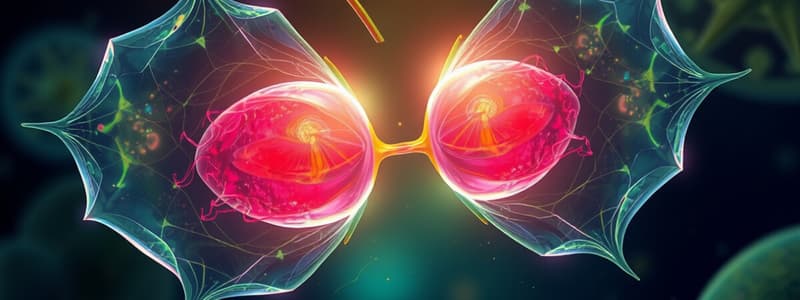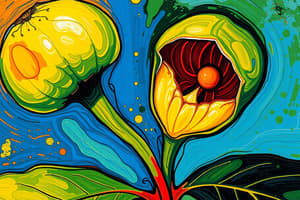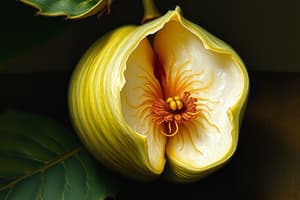Podcast
Questions and Answers
Match the following terms with their definitions related to seed structure:
Match the following terms with their definitions related to seed structure:
Embryo = Part of the seed that will develop into the new plant Testa = A tough and hard seed coat which protects the seed before germination Radicle = First part of the new plant to emerge from the seed, develops into the root Plumule = Emerges soon after the radicle, develops into the shoot
Match the types of seeds with their characteristics:
Match the types of seeds with their characteristics:
Endospermic seeds = Food required by the developing embryo is stored in the endosperm Non-endospermic seeds = Food is stored in seed leaves called cotyledons Monocots = Plants that have one cotyledon Dicots = Plants that have two cotyledons
Match the following stages of seed formation with their descriptions:
Match the following stages of seed formation with their descriptions:
Zygote = Forms the seed embryo Endosperm nucleus = Divides rapidly to form a food storage tissue Ovule = Develops into the seed Integuments = Thicken and toughen to form the testa
Match the type of fruit development with its method:
Match the type of fruit development with its method:
Match the fertilization process terms with their roles:
Match the fertilization process terms with their roles:
Match the following seed dispersal methods with their descriptions:
Match the following seed dispersal methods with their descriptions:
Match the following terms with their definitions:
Match the following terms with their definitions:
Match the following advantages of dormancy with their purposes:
Match the following advantages of dormancy with their purposes:
Match the following examples with their dispersal methods:
Match the following examples with their dispersal methods:
Match the following types of plant hormones with their functions:
Match the following types of plant hormones with their functions:
Match the following components of seeds with their descriptions:
Match the following components of seeds with their descriptions:
Match the following processes with their stages in seed formation:
Match the following processes with their stages in seed formation:
Match the following factors affecting germination with their influences:
Match the following factors affecting germination with their influences:
Match the following biological phenomena with their meanings:
Match the following biological phenomena with their meanings:
Flashcards are hidden until you start studying
Study Notes
Double Fertilisation and Seed Formation
- After fertilisation, the ovule swells, and its wall toughens to form the seed coat (testa).
- The zygote develops into the seed embryo while the triploid endosperm provides food storage.
- The outer wall of the ovule, known as integuments, thickens to form the testa.
- Once formed, the seed dries out and enters a dormant state.
Seed Structure
- Embryo: The future plant developed from the zygote.
- Testa: A hard seed coat that protects the seed until germination.
- Radicle: The first part to emerge from the seed, developing into the root.
- Plumule: Emerges after the radicle and becomes the shoot.
- Cotyledons: Seed leaves containing food reserves for early germination; monocots have one cotyledon, dicots have two.
Types of Seeds
- Monocots (like maize and wheat) store food in the endosperm, classified as endospermic seeds.
- Dicots (like broad beans) store food in cotyledons, classified as non-endospermic seeds.
Fruit Formation
- The fruit serves to protect seeds and facilitate their dispersal.
- Seedless fruits, like watermelons, can be produced by:
- Genetic selection for low-seed plants.
- Using hormones like auxins to induce fruit without fertilisation.
Seed Dispersal Methods
- Animal Dispersal: Animals eat fruit, and seeds pass through their digestive systems, necessary for germination in some plants (e.g., tomatoes).
- Wind Dispersal: Seeds are lightweight with a large surface area to be carried by the wind, as seen in sycamore and dandelion seeds.
- Self-dispersal: Pods dry, curl, and split open to release seeds, e.g., in gorse plants.
- Water Dispersal: Seeds with air pockets float for dispersal, like yellow water lilies.
Dormancy
- Dormancy refers to a state of metabolic inactivity in seeds, even when germination conditions are favorable.
- Advantages:
- Avoids adverse conditions that could harm growth.
- Allows time for seed dispersal to reduce competition.
- Provides time for embryo maturation.
Breaking Dormancy in Agriculture
- Seeds maintain dormancy through a waterproof testa that prevents water entry, delaying germination.
Plant Reproduction Overview
- Sexual reproduction involves fertilisation of gametes, while asexual reproduction does not.
- Sexual reproduction in plants typically occurs through flower structures.
Functions of Flower Parts
- Sepals: Protect the flower before and during its opening.
- Petals: Bright and often fragrant to attract pollinators.
- Stamens:
- Male reproductive part composed of:
- Anther: Produces pollen (male gametes).
- Filament: Supports the anther.
- Male reproductive part composed of:
- Carpel:
- Female reproductive part with:
- Stigma: Captures pollen.
- Style: Connects stigma to ovary.
- Ovary: Contains ovules which develop into embryos.
- Female reproductive part with:
- Nectary: Produces nectar to attract pollinators.
Gamete Development
- Female Gametes: Formed in the ovule, a diploid megaspore mother cell undergoes meiosis, producing four haploid megaspores; three degenerate, leaving one that divides mitotically to create eight nuclei, forming the embryo sac.
- Male Gametes: Located in the anther, diploid microspore mother cells undergo meiosis to produce four haploid microspores.
Studying That Suits You
Use AI to generate personalized quizzes and flashcards to suit your learning preferences.




